Research Projects

Researcher(s)
Research Project(s)
Pholsena, Vatthana
The Afterlife of the Cold War in Central Laos and Northeast Thailand
The Afterlife of the Cold War in Central Laos and Northeast Thailand
Vatthana Pholsena
This research project investigates contemporary experiences as well as after-effects of the Cold War in a borderland area straddling central Laos (Khammuan Province) and northeast Thailand (Nakhon Phanom Province). This area was a key front line during the conflict: a large U.S. military airbase was established outside Nakhon Phanom town from which operations were conducted over Laos, while Nakhon Phanom province was the site of armed conflict between the Communist Party of Thailand and Thai government counter-insurgency forces.
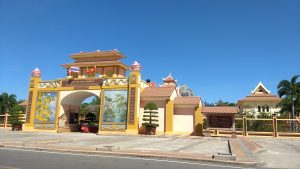
A ‘cultural turn’ in Asian Cold War studies has enriched the field by emphasizing the importance of ideology, culture and identity. Factors such as local politics, ideology and state policies, as well as race, ethnicity, and a transnational culture and history, influenced to varying degrees people’s actions during the Cold War. This project aims to reconstitute otherwise unknown biographies and personal trajectories in times of political, social and cultural upheaval that have (re)shaped people’s sense of self and of belonging. It also examines memory practices and temporal topographies, and their effects on social life. This research argues that the deep-seated politics of the Cold War have an afterlife; they are culturally present and socially potent in both Lao and Thai societies, especially at the countries’ ‘margins’ where the conflict was most violent.
The project is currently funded by an NUS Start-Up Fund and fieldwork, which started in 2018, is planned to continue until 2024. This research is benefitting from a collaboration with faculty at the University of Khon Kaen, Thailand.
Daquila, Teofilo C.
International Student Mobility: A Comparative Study Between Australia And Singapore
International Student Mobility: A Comparative Study Between Australia And Singapore
Teofilo C. Daquila
Using primary and secondary sources of information, this research examined the extent of international student mobility in Australia and Singapore. Case studies were conducted by examining three prestigious institutions of higher learning such as the Australian National University, the University of Sydney, and the National University of Singapore. These universities have been recognised among the top universities in the world by several media organizations including the Newsweek (Aug 2006), and the Times Higher Education Supplement (2006). This study analysed the trends and patterns of international students in these universities. It also investigated the different contributory factors particularly in terms of the policies adopted by these institutions. It also examined the contribution of their respective governments in promoting student mobility. Results of this study were presented at the 2007 Global Higher Education Forum in Kuala Lumpur, Malaysia in Nov 2007 which was co-organized by the Ministry of Higher Education Malaysia, the International Association of Universities (IAU), and National Higher Education Research Institute (IPPTN). It was published as a book chapter titled “"Internationalising Higher Education in Australia and Singapore". In Contemporary Issues in the Global Higher Education Marketplace: Prospects and Challenges, edited by Morshidi Sirat and Sarjit Kaur. University Sains Malaysia, Penang: National Higher Education Institute (IPPTN), 2010. 28 pp.
Internationalising Higher Education in the Asia Pacific: Case Study of Australia, Japan and Singapore
Internationalising Higher Education in the Asia Pacific: Case Study of Australia, Japan and Singapore
Teofilo C. Daquila
With his many years of overseas experiences as international student, educator and scholar, Teofilo C. Daquila has conducted his research on the internationalisation of higher education (IHE), as it has become an important policy issue and research topic. Firstly, he aims to determine the extent of internationalisation of higher education in the Asia-Pacific region particularly in Australia, Singapore and Japan in terms of its four indicators such as: (i) expansion, (ii) liberalisation / deepening, (iii) broadening / diversification, and (iv) facilitation. Secondly, he intends to identify and discuss the various determinants and impacts of IHE using a multi- and inter-disciplinary framework of analysis, ie. historical, political, geographical, economic, social and cultural dimensions. Finally, he intends to use three leading universities in the world as case studies to determine their internationalisation strategies and the extent of their competitiveness. These are the University of Melbourne (UoM) for Australia, the National University (NUS) of Singapore for Singapore, and Kyoto University (KU) for Japan. Daquila uses four indicators of competitiveness: governance and structure, internationalisation strategies (through expansion, broadening/diversification, deepening and facilitation), demand conditions, and factor conditions. Results of this study were published in the following journal and presented in the following conferences/seminars:
“Internationalising Higher Education in Singapore: Government Policies and the NUS Experience”, Journal of Studies in International Education, Vol.17, no.5 (2013): 629-647. (United States).
Australia – “Internationalising Higher Education in Australia & The Competitiveness of the University of Melbourne”, Melbourne Centre for the Study of Higher Education, The University of Melbourne, Australia, 22 March 2017.
Japan – “Internationalising Higher Education in Japan & the Competitiveness of Kyoto University”, Centre for Southeast Asian Studies & The Office of Internationalisation Strategy, Kyoto University, Japan, May 2017.
Singapore – “Internationalising Higher Education: Perspectives from Kyoto University, University of Melbourne & the National University of Singapore “, NUS: Dept of Southeast Asian Studies, 1 Nov 2017.
Japan – “Student Mobility in Asia & the Pacific: Expansion, Broadening & Deepening” Presented at University Mobility in Asia and the Pacific UMAP International Forum 2018, Osaka University of Commerce, Osaka Japan. Sep 2018.
Japan - “Internationalising Higher Education in Japan, Australia and Singapore”, Fully-sponsored presentation at the Roundtable Discussion on International Education, Toyo University, Japan, 27 Sep 2018.
Mohamed Effendy
Preserving Intangible Cultures: Documenting and recording the history and culture of Malay martial arts groups in Singapore (2018-2020)
Preserving Intangible Cultures: Documenting and recording the history and culture of Malay martial arts groups in Singapore (2018-2020)
Mohamed Effendy
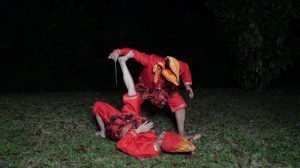
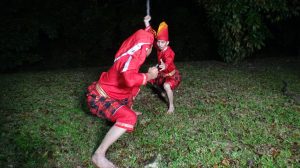
Pencak silat is an ancient form of self-defence that originated in maritime Southeast Asia and this project aims to understand the origins of these cultural systems and how it is used by communities today as a powerful device to reclaim historical and cultural pasts. It is supported by a $90,000 grant by the National Heritage Board of Singapore and the research lasted from 2018 to 2020.
The project records the oral history, styles and origins of Malay martial art groups in Singapore and it contributes to a more nuanced insight to the origins and development of the Singapore Malay community. It found that many early members of Malay martial arts groups migrated to Singapore during the 19th and early 20th century from Sumatra, Java, Sulawesi, the Riau-Lingga islands and the Malay Peninsula. Men of martial skills settled down in various areas of Singapore and established the earliest martial arts schools. The project also recorded the historical memories and Pencak Silat skills of many schools in Sulawesi, Indonesia and they contain new and exciting insights about the role of men with martial skills from Sulawesi in the history of Singapore and Southeast Asia.
The project will be showcased on roots.gov.sg
A History of Silat Seni Gayong PASAK of Singapore. Silat Seni Gayong Singapura (2016-2017)
A History of Silat Seni Gayong PASAK of Singapore. Silat Seni Gayong Singapura (2016-2017)
Mohamed Effendy
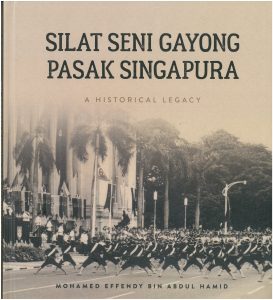
In 2016-2017, the National Heritage Board of Singapore gave a $37,000 grant to support the writing and publication of a book on one of the oldest Malay Martial arts groups of Singapore called Silat Seni Gayong PASAK of Singapore. The group was founded in the 1940s by Dato Meor Rahman on Pulau Sudong, Singapore and it aims to provide a new understanding of the role martial arts in the historical, cultural and social development of the Singapore Malay community. More importantly, it demonstrates the importance of preserving Singapore’s unique cultural heritage and achievements and break new ground for research on the importance of martial arts in Singapore’s history.
Johnson, Irving C.
Creative Project: Painting the walls of Uttamayanmuni Buddhist temple, Singapore
Creative Project: Painting the walls of Uttamayanmuni Buddhist temple, Singapore
Irving C. Johnson
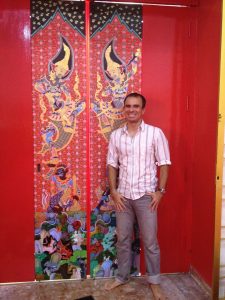
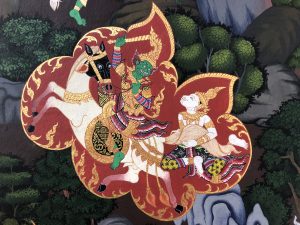
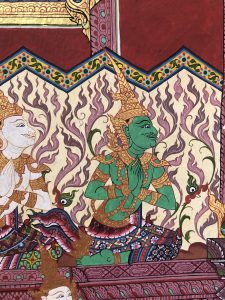
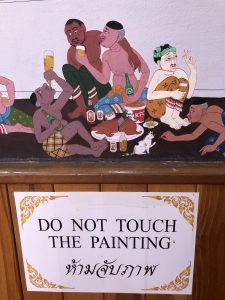
This is a large ongoing project to paint traditional Thai murals on the inner walls of the main hall of Uttamayanmuni Buddhist temple in Singapore.
The project is unfunded and currently in its eighth year. I am sometimes assisted by some students who have read my SE3224 Thai Drawing and Painting Module.
Exploring The Social Life of Balinese Masks
Exploring The Social Life of Balinese Masks (ARF Grant- Tier 1)
Irving C. Johnson
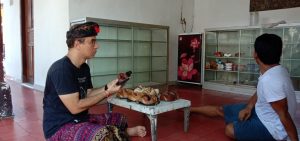
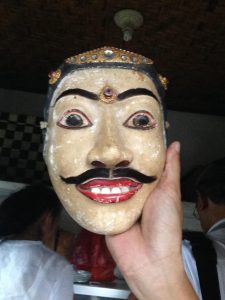
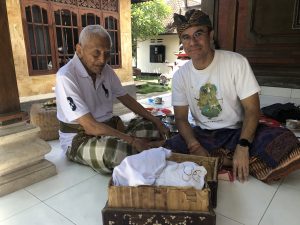
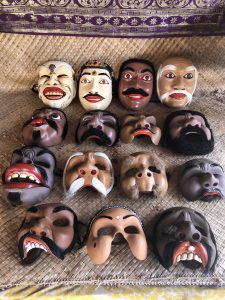
This project is a first of its kind in the field of Balinese studies and looks at the social life of Balinese topeng masks. Earlier research on masked theater in Bali have focussed primarily on the genre’s dramatic structure and on the role of masks within the art form and culture. My ethnographic project locates masks as the living products of carvers and discusses how mask makers understand their craft. The project is very large and attempts to look at mask making across Bali and through history. I work closely with mask makers and dancers as well as the collection held in the Bali Museum in Denpasar. Close attention will be focussed on the role of masks in pre-colonial Balinese politics and the changing significance of topeng masks in contemporary Bali. The project involves recording interviews with Balinese mask makers and creating a photographic template of their creations.
The People With Two Kings
The People with Two Kings
Irving C. Johnson
Looming large over Kelantan’s countryside are colorful statues of immense size. The northern Malaysian state, which has for a long time been described by many as a Malay cultural heartland as well as a hotbed of Islamic radicalism, boasts some of the largest Buddhist creations in Asia. “The People with Two Kings” focus on the builders of these magnificent religious monuments. It explores how Thai Buddhists living in Kelantan showcase their identity as culturally Thai and yet patriotically Malaysian. They achieve this through everyday practices that often involve complex patterns of travel and cross-cultural interaction. In order to build the statues that have now placed Kelantan on the Malaysian tourist map, Kelantanese Thai minority have been forced to rethink their traditional associations with other ethnic groups in the state such as the Malays and Chinese. It has also meant a retelling of local history. Living so close to the Thai border has brought Kelantan’s Thai population under the watchful gaze of the Thai government even though the Kelantanese Thais are Malaysians and proudly swear allegiance to the state’s Malay Muslim sultan. Thus, this small community is faced with the complex question of what it means to be Thai living in a contemporary Malaysian state.
Dr Irving C Johnson’s ethnographic project “The People with Two Kings” is an account of identity, space and history in the little known Buddhist communities of Kelantan, Malaysia. Long associated with Islam and traditional Malay culture, scholars of Kelantanese society have often overlooked the presence of the state’s nearly ten thousand Thais. Erroneously labeled Siamese by some, Kelantan’s Thai Buddhist population live in primarily ethnically homogenous villages. Having abandoned wet rice cultivation since the seventies, many Thais now practice intensive vegetable and tobacco cultivation. Kelantan’s low levels of socio-economic development have meant that many younger Thais have been forced to move outside the state to seek waged employment. Many have migrated to the urban belts of Johor Bahru, Kuala Lumpur and Penang. The large economic rewards to be gained from cash cropping and urban employment coupled with a vibrant national economy is clearly displayed in the village landscape. Gated concrete mansions have replaced many older wooden houses, and the internet and wireless broadband have found its way into distant villages. Dirt tracks have been transformed into paved roads and villagers have become part of moving landscapes marked by cars, bicycles, motorcycles, budget airfares and media images. Yet despite the influx of modernity into these villages, vestiges of history remain, in particular through the mobile culture of village life.
Living so close to Thailand (the Thai border towns of Sungai Golok and Tak Bai being only a short drive from some villages) has meant that Kelantan’s Thai population has been strongly influenced by people and events that take place across the border. In 1909, British and Siamese officials demarcated Kelantan’s northernmost frontier from an independent Siam. Nevertheless, the new divide did little to prevent cross-border movements. Kelantan’s Thai villagers have historically traveled between Malaysia and Thailand on a regular basis. Before the British and subsequent Malaysian administration’s construction of road and rail networks, Kelantanese Thai traveled shorter distances – often moving between villages. Today, new forms of mobility have forced Kelantanese Thais to rethink the meaning of travel and its impact on their lives. In his project, Dr Johnson addresses the relationship between traditional forms of mobility and contemporary cross border flows and the effect this has had on the way Kelantanese Thai speak about and perform their identity.
The mobilities inherent in travel circuits that define the space of Kelantan’s borderland villages often blur the meanings of identity for the people who engage with these movements. One result of this has been the constant attempts by representatives of certain cultural bodies to effectively “standardize” Kelantanese Thai culture (art, architecture, language, bodily stance, etc) so that it mirrors Thailand’s self definitions of what Thai culture is. But these practices are often part of larger national processes that emanate from faraway metropolitan centers. Besides the physical movement of people, Kelantanese Thai villages are saturated with media images emanating from both Thailand and Malaysia. Dr Johnson’s work documents the impact of these grandiose nationalism projects on the lives of the Malaysian Buddhist villagers. He shows how the stereotypes associated with national projects of cultural and political citizenship are interpreted in a myriad of ways by the people. Through their engagement with these projects of cultural standardization, Kelantanese Thais reaffirm their multilayered identities as Thai, Buddhist, Kelantanese and Malaysian. By living in one Kelantanese Thai village for 16 months and participating in the lives of the people, Dr Johnson displays the creative genius of people often considered marginal and powerless. He achieves this through tracing the trajectory of their lives and in listening to the way they talk about it. Cultural creativity, Dr Johnson argues, is intimately woven in the everyday practices of the people and in the way they speak about the world they live in and of the past they remember. These practices are defined by space and the historical and contemporary movements that crisscross them.
Local Histories of Kelantan's Thai Temples
Local Histories of Kelantan's Thai Temples
Irving Johnson
This research is a joint project with the Royal Thai Consulate of Kota Bharu, Kelantan, Malaysia and the Kelantanese Thai Association (Persatuan Siam Kelantan).
Funded by the Royal Thai Consulate, this project was initiated by Dr Johnson in 2007 with a grant under the Staff Research Support Scheme. The project involves both local researchers from Kelantan’s Thai villages as well as academics from Malaysia and Thailand including anthropologist Professor Mohamed Yusoff Ismail of the Malaysia Open University and Thailand’s famed historian Professor Tej Bunnag who has agreed to help oversee the work’s completion. Kelantanese Thai research assistants have also been employed to conduct interviews with Thai villagers and to gather much needed ethnographic information on the history of the temples.
The project aims to produce a compilation of essays and historical treatises on the twenty Thai Buddhist temples of Kelantan. The book (tentatively titled The History of Kelantan’s Thai Buddhist Temples) will be written in Thai and subsequently translated into English and Malay. The book is a first attempt at documenting the history of all of Kelantan's Thai temples and a bridge by which local villagers and scholars can work together in producing a text that is important to both groups.
Kammen, Douglas
Violence and History in East Timor
Violence and History in East Timor
Douglas Kammen
Building on fieldwork and archival research conducted from 2001 until 2007, Dr Douglas Kammen started on two related research projects on history and violence in East Timor.
The first project explores the historical development of communal identities, central power, violence, and popular political thought in East Timor over the past three hundred years. Five of these articles have already been published, are forthcoming, or are under review. These include: “Master-Slave, Traitor-Nationalist, Opportunist-Oppressed” (journal Indonesia and forthcoming in Portuguese Literary and Cultural Studies), “Fragments of Utopia: Popular Yearnings in East Timor” (forthcoming in Journal of Southeast Asian Studies), “Between Violence and Autonomy” (forthcoming in book to be published by ISEAS), “Civil-Military Relations in East Timor” (forthcoming in a Routledge volume on the military in Southeast Asia), and “Subordinating Timor: Central Authority and the Origin of Communal Identities” (under journal review). The author is completing further studies on the feudalization of Portuguese Timor and the politics of food security.
The second project explores the political history of violence in one locality in East Timor over 300 years. Whereas much of the scholarship on East Timor adopts a national perspective, this research focuses on local meaning and understandings of the past and present. This work seeks to highlight the local origins of violence in 1999 and the reasons for the exclusion of local knowledge from national narratives. Material for this project is drawn from fieldwork and archival material from Macau and Lisbon.
Mrázek, Jan
One East to Another: Eastern European Travels in Colonial Southeast Asia
One East to Another: Eastern European Travels in Colonial Southeast Asia
Jan Mrázek
Scholarship on European representations of (Southeast) Asia in the colonial period largely deals with western European colonial powers and their particular imagination, political relationships, orientalisms, and racisms. It is on this limited, empire-centric perspective that generalizations about “Europe”, “the West”, and “Western” views of “the East”, are usually based. This project complicates this picture by focusing on the experiences and writings of individuals who travelled to/in colonial Southeast Asia from “eastern Europe”—Czechs, Hungarians, Poles, Serbs, etc. Their complex, ambiguous identities were particularly creatively performed or fabulated on their travels. They came from the “semi-barbarous,” borderlands between the West (or “Europe”) and the East, where world-divisions and hierarchies were variously mimicked, appropriated, undermined or ridiculed, and where manifold identities were lived and dreamed in the margins, or under the rule, of great empires, West and East, which aimed to divide the region among themselves, rather like Western European colonial powers did in Southeast Asia. The travellers came from (often stateless) nations that did not have Asian colonies, were at times (semi-)colonized, and were orientalised in Western perspectives. On their travels, as they observed and entered colonial society with its racialized hierarchies, their self-images, as well as their perceptions of Europe and Asia, or East and West, crystalized or were shattered in new, intense ways. They saw and described the similarly complex, multi-ethnic and changing world of colonial Southeast Asia in the mirror of the complexities, contradictions, conflicts and dreams of their own societies and life experience. The international workshop Escaping Kakania: Eastern European Travels in Colonial Southeast Asia was organized in March 2021 under the title (The project is supported by an MOE research grant.)
Primeval Forest, Homeland, Catastrophe: Travels in Malaya and “Modern Ethnology” with Pavel Šebesta / Paul Schebesta
Primeval Forest, Homeland, Catastrophe: Travels in Malaya and “Modern Ethnology” with Pavel Šebesta / Paul Schebesta
Jan Mrázek
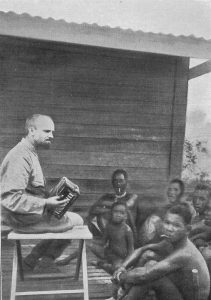
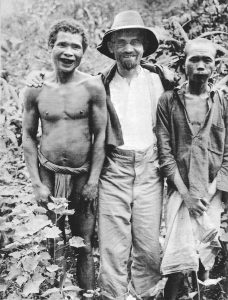
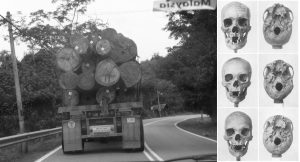
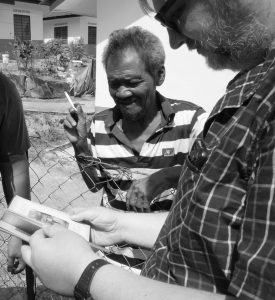
The ethnologist/ethnographer mostly known as Paul Schebesta (1887-1967) was often introduced in Czechoslovakia as “our Czech” Pavel Šebesta. Querying origins, selves and homelands, his own and in his writings (ethnography/travelogues/fiction on “dwarfs” in the “primeval forest”), the project explores the multiplicity/borderlands/nomadism of Schebesta/Šebesta, also in his relation to the “Other,” a concept/distinction/border that is thus destabilized or blurred. Interweaving apparently separate questions about his life and scholarship, we find continuities and mirrorings across distance and otherness. Following-mirroring Šebesta/Schebesta, we recognize the familiar in the strange, Silesia/Moravia in Malaya, the contemporary in the primeval, the native in the ethnologist, the head-hunter in the biological anthropologist. The project, like all my projects, is also an experiment in writing. My two-part essay on Schebesta is published in Anthropos (2021), where Schebesta also published (as well as serving as its Editor for some years). The essay’s motley style mirrors what has been described as Schebesta’s “jumbled” writing, “highly coloured … scarcely in consonance with the scientific material”; it reflects his nomadism, emphasis on “experiencing together,” and the conflict that he sensed between “theories” and “life, rhythm, poetry.” (The project was supported by grants from the MOE.)
On this Modern Highway, Lost in the Jungle: Tropics, Travel, and Colonialism in Czech Poetry
On this Modern Highway, Lost in the Jungle: Tropics, Travel, and Colonialism in Czech Poetry
Jan Mrázek
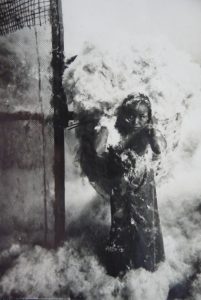
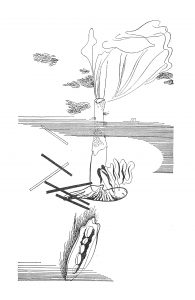
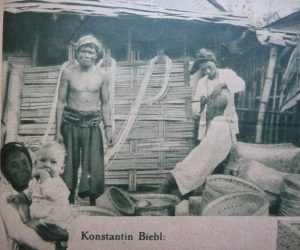
Konstantin Biebl (1898-1951) was a well-known Czech avant-garde poet, a communist and a surrealist in complicated and shifting ways. In 1926, Biebl travelled from Prague to Java via Ceylon and Singapore. He, his trip, and his poetry (and photographs) are at the core of the book project, but they are also an entry point to a broader reflection on poetic thinking about home and the foreign, about travel and/as poetry, from nineteenth century Czech romanticism to the interwar avant-garde, and to post-war poetics and politics under Socialism where Biebl committed suicide. More than a biography, it is a conversation about poetry and poetic travel — specifically, travel between Bohemia, with its particular history of being “colonized”, uniquely “Eastern” and uniquely “European”, and Java under the Dutch; about modernity, colonialism, race, distance and distinctions, and how they are overcome or not by travel and poetry. A book resulting from this project, under the same title, will be published jointly by Karolinum Press (Charles University, Prague) and NUS Press in 2022. (The project was supported by grants from the MOE.)
Czechs on Ships: Liners, Containers and the Sea
Czechs on Ships: Liners, Containers and the Sea
Jan Mrázek
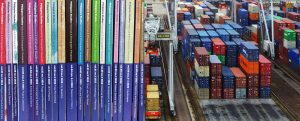
To understand better sea travel in the colonial period and how world then is like and unlike ours, in 2014 I sailed on a container ship from Rotterdam to Singapore. The essay based on the experience juxtaposes, as in a poetic metaphor, Czech sea voyages to Southeast Asia in the late colonial era, as described in their writings, and my own voyage. A reflection on sea travel and an experiment in historical research, it is an account of accessing the past through the experience of a voyage. I reflect on size, speed, time, and modernity; on containers, classes, nations, colonies, and empires, past and present.
How can our present journeys help us grasp the experiences of past travellers, as well as our relationship with them, our nearness and our distance? How can old travelogues enrich our perception of present-day travel, shipping, and colonialisms? How do present, past and future overflow into each other, on the fluid borders between physical, economic and industrial reality and narrative/poetic imagination? How is containerisation, whose (pre)history this essay traces, part of our “knowledge production”? My writing performs these questions with a Czech accent that reflects a specific historical situation and the self-image of a variously colonised European people who navigate(d) in particular, often clownishly improper ways, in the world of colonies and empires, old and new. (The project was supported by an MOE research grant.) 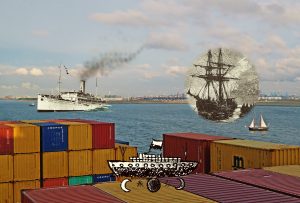
From Bohemia to the Malay Archipelago: Travels in Imagination and in Reality
From Bohemia to the Malay Archipelago: Travels in Imagination and in Reality
Jan Mrázek
A number of Czechs travelled to and wrote about the Malay Archipelago in the colonial period, and more make the trip now or read about and imagine the tropics. What does tropical jungle, the ocean, dark-skinned women and British and Dutch colonists mean in Bohemia, a small landlocked country which never had a colony, from which one had to travel through other countries such as France and Italy to see the sea and seagoing ships, and which politically and culturally was in some ways in the position of a colony in relation to its more powerful European neighbours? What dreams, desires, perceptions and truths do these images embody? How can one write about the Czech case without fitting it into pre-existent colonial and postcolonial schemes of power, meaning, and interpretation, such as labelling images and narratives, which have their own truth and power, as colonial, anti-colonial, Czech, European, Orientalist, same or different?
The research project by the FASS’s own Bohemian, Assoc Prof Jan Mrázek, aims to answer questions regarding Czech images and experiences of the Malay Archipelago from within their imaginative world and to explore them through the thickness of images, thoughts, and dreams of distant lands, foreignness, otherness, as well as their opposites, the self, the home, the everyday actuality. It aims to explore how the specific historical experience of Bohemia lead to particular ways of relating to and imagining the Malay Archipelago; and to show how a reflection on a little-known, “marginal” European literature, imagery, and experience of the tropics can nuance our understanding of trans-continental travel and “European” perceptions of Asia, colonialism, and racism.
The primary historical focus is the latter part of the colonial era (approximately 1870s-1940s) although continuities with earlier and especially later times will be also explored. The project will combine archival and library research with travel to places visited by Czech travellers and a voyage on a cargo ship from Europe to Singapore.
Indigenous Classical Music In Contemporary Indonesia And Thailand: Toward A Comparative Regional Perspective
Indigenous Classical Music In Contemporary Indonesia And Thailand: Toward A Comparative Regional Perspective
Jan Mrázek
Most of existing research on Southeast Asian music tends to focus on the study of a single kind of music and musical culture in Southeast Asia. This research however is comparative, emphasizing field research and first-hand, in-depth study of different kinds of music by a single researcher in more than one Southeast Asian country.
The research is concerned both with musical sounds, structures, and aesthetics, and with cultural and social issues relevant to understanding the different kinds of music, from the traditional roles of music in different societies to issues concerning modernization, globalization, commodification, and recontextualization of music, new ways of learning and teaching music, the use of music by the state, and so on. Such in-depth comparative research of Southeast Asian music is made possible in part by Singapore location in the region, which enables the researcher to travel easily to Southeast Asian countries for fieldwork. Postgraduate students researching music are encouraged to study more than one kind of music – for example, Ms Tan Li Ching, whose main focus is Burmese music, has also seriously studied Thai and Javanese music; and Dr Thomas Manhart, who recently finished his dissertation on the music of Nias (a small Indonesian island west of Sumatra) also studies and performs Sundanese, Minang, Javanese, and Thai music.
Miksic, John N
Buddhist Murals of 11th through 13th Centuries in Bagan, Myanmar
Buddhist Murals of 11th through 13th Centuries in Bagan, Myanmar
John N. Miksic
The site of Bagan lies in north-western Myanmar, in the dry zone which formed the centre of Burmese civilization. The kings of Bagan ruled over much of Myanmar between the 11th and 13th centuries. Bagan enjoyed wide-ranging contacts with many countries including China, India, Sri Lanka, Thailand and Cambodia.
The art of Bagan has been called one of "three great manifestations of Hindu-Buddhist art in Southeast Asia", along with Java and ancient Angkor (Chihara, 1996: 167). This high status was achieved mainly in the field of architecture; Bagan's buildings have special features, whereas its sculpture is usually judged to be conventional and of only average merit. The focus on the architecture of Bagan, while well warranted, has resulted in the neglect of the site's most important treasures: thousands of square metres of mural paintings. Bagan's murals form by far the largest collection of ancient Southeast Asian painting in existence. Their artistic merit of many is very high. From a historical standpoint they form a very important source of potential knowledge regarding the relationship between Buddhism, the rise and fall of the kingdom, and Southeast Asian Buddhism during a transitional period which led to the implantation of Theravada Buddhism as the majority religion on the entire Southeast Asian mainland. Despite the enormous interest of these paintings, both aesthetically and intellectually, no detailed studies of them have ever been published.
There are no complete visual records of Bagan's murals. As a result, a critical source of data is in constant danger of being lost, either because of natural disasters such as earthquakes, or human agency. A project to digitize the murals of the 300 - 400 temples is urgently needed so that a major portion of Myanmar's past can be safeguarded against the ravages of time, and made more accessible to scholars.
A/P Miksic began the preliminary stages of a digitization project in 2000 with a PhD candidate from Myanmar under my supervision, Mr Win Than Tun. He completed his PhD and returned to Myanmar. Since then I have been working with a graduate of the Southeast Asian Studies Programme, Dr. Goh Geok Yian, who received her doctorate from the Department of History at the University of Hawaii at Manoa on ancient Bagan's history in 2008 and now is a lecturer at NTU. She has received a start-up grant from NTU which we are using to pursue the digitization of these murals and to develop an interactive website which will make them available to all scholars and interested students.
Population, Trade And Settlement In Early Southeast Asia
Population, Trade And Settlement In Early Southeast Asia
John N. Miksic
This project targeted archaeological excavation and analysis of artefacts from proto-historic sites in Southeast Asia that formed links in networks of ancient exchange and communication networks. Early historic (ca. 11th-16th centuries AD in Maluku; 1st to 6th centuries AD in Cambodia and Myanmar; 11th century in Jambi, Sumatra) settlement, exchange, communication and influence within Southeast Asia are under-researched topics.
The analysis conducted through this project constitutes an important component of multi-disciplinary long-term research conducted by A/P John Miksic and his collaborators. These include the University of Hawaii Sago Project in Maluku in 1990, the Creativity and Culture Program of the Rockefeller Foundation grant to the Center for Khmer Studies, Siem Reap, Cambodia; and the Osteoarchaeology Research Group, NUS. Preliminary survey and testing was conducted as part of D. Kyle Latinis’ Ph.D. dissertation work with the National University of Singapore. Fieldwork for the project was conducted in Maluku, Singapore, Cambodia, and Myanmar.
The project supported fieldwork to acquire samples, which were analyzed using archaeological tests of age and artefact composition vital to satisfying professional standards for archaeological reporting and interpretation. Because of the scarcity of interdisciplinarians working in Southeast Asian archaeology however, they have rarely been applied in this region.
Objectives of this project included:
-
Acquisition of vital new information regarding the evolution of Southeast Asian civilization and the role of maritime trade in that process
-
Breaking new ground in the study of the physical remains of early Southeast Asian people.
-
Exploitation of interdisciplinary methodology through the application of archaeological laboratory methods (radiocarbon dating, energy dispersive x-ray fluorescence compositional analyses, scanning electron microscopy, and thin section petrography) to archaeological materials from Maluku, Cambodia, and Myanmar.
-
Expansion of newly-formed connections between the Southeast Asian Studies Programme, NUS, and Cambodian institutions including the Center for Khmer Studies and the Royal University of Fine Arts.
-
Training of students in advanced laboratory techniques
-
Collaborative arrangements were made with the Physics Department’s Energy Dispersive X-Ray Fluorescence laboratory. The Osteoarchaeology Research Group (ORG) at NUS obtained rights to study two 2,000-year-old skeletons discovered at Angkor, Cambodia, by the École Française d’Extrême-Orient. APSARA, the Khmer institution which supervises the development of the Angkor region, was fully involved in the project. At NUS, the ORG consists of approximately 10 specialists from the Faculty of Medicine and 2 from the FASS. The radiocarbon analysis and petrographic sampling required the use of labs outside of Singapore which specialize in scientific analyses of archaeological material.
Future research projects connected with these overall goals include analysis of ceramics and other artifacts found at the “palace site” in Bagan in January, and excavations in Jambi, Sumatra, and Sanur, Bali, in 2014.
Archaeological Excavations In Phnom Kulen, Cambodia
Archaeological Excavations In Phnom Kulen, Cambodia
John N. Miksic & Wong Wai Yee
Phnom Kulen is a plateau about 50 km northeast of the famous Angkor Wat. The devaraja ritual establishing the kingdom of Angkor was conducted there in A.D. 802. Recent survey using a new form of airborne remote sensing called Lidar has revealed many unsuspected structures from the Angkor period hidden beneath the jungle. An excavation with Dr. Ea Darith of Apsara is planned for February 2014 to investigate some of these newly found features.
Khmer Potters Emerge from the Shadows
Khmer Potters Emerge from the Shadows
John N. Miksic
One of Cambodia’s earliest capitals was Roluos, 30 km southeast of Angkor Wat. In January 2007 a joint team from NUS including Assoc Prof John N Miksic and Mr. Chhay Rachan of the APSARA Authority which takes care of Angkor and the Royal University of Fine Arts excavated an ancient centre of Khmer ceramic production at Thnal Mrech, on the Phnom Kulen plateau. Carbon dates proved that the site was used in the early 11th century. In January 2008 the same team excavated another site, this time near Bakong, one of the first temples to be built in the Angkor area. The area was being landscaped to build a new administrative complex for the government, so work had to be done quickly. Surface exploration in December 2007 discovered a large number of kilns (39). In January 2008, rescue excavations were performed at two of the more promising sites. Both yielded ceramics and remains of kiln structures. A carbon date indicates that the kilns were operating around AD 900. Historically this period is significant because the center of activity was in the process of moving from Roluos to Angkor. The excavations show that Roluos was one of the earliest, and possibly the very first, site in the Angkor region to produce high-fired ceramics (a technically advanced stage of technology). A conference paper on this project was presented in Leiden, Netherlands, on September 3, 2008, to the 12th International Conference of the European Association of Southeast Asian Archaeologists (EurASEAA). In 2012 A/P Miksic co-directed a project at Torp Chhey, another early Khmer kiln site east of Phnom Kulen, with Dr. Ea Darith of the Apsara Authority. This excavation uncovered the largest kiln yet found in Cambodia, and possibly in Southeast Asia. In June 2013 Prof. Miksic collaborated with Mr. Phon Kaseka and the Royal Academy of Cambodia on the excavation of a group of kilns at Cheung Ek, near Phnom Penh. This site yielded a date in the 5th or 6th century, making it one of the oldest kilns anywhere in Southeast Asia. Research on Khmer ceramic sites is continuing in the endeavour to explore the development of this form of technology in Cambodia.
Archaeological Research on the Dieng Plateau, Java
Archaeological Research on the Dieng Plateau, Java
John N. Miksic
Assoc Prof John Miksic led an archaeological excavation on the Dieng Plateau, one of the oldest religious complexes in Southeast Asia from 2 to 12 June 2010. Stone temples there are believed to date from the early 8th century. They were originally Hindu, but at least one was converted to Buddhist use. Previous research has focused on the temples, but no attempt had been made to search for information on activities conducted around them. A large portion of the Plateau was covered by wooden buildings built on stone foundations, meant to accommodate pilgrims and priests. The excavation was sponsored by grants from the University Scholars Programme (USP), the Nalanda-Sriwijaya Centre (ISEAS), and Nanyang Technological University. Dr Mahirta from the Department of Archaeology, Universitas Gadjah Mada (UGM), was the project’s main Indonesian counterpart. The excavations discovered remains of pottery including numerous types of Chinese ceramics of the late Tang Dynasty. Analysis of the finds has been conducted in the archaeological laboratory at UGM. These discoveries shed important light on the distribution of Chinese ceramics in 9th-century Java, and on the famous shipwreck found off Belitung with a huge cargo of Chinese wares on board. The Dieng discoveries support the hyothesis that the ship, an Arab dhow, was bound for Java when it sank around 832.
Archaeological Excavation at Cheung Ek, Cambodia
Archaeological Excavation at Cheung Ek, Cambodia
John N. Miksic
The area of Cheung Ek, on the outskirts of Phnom Penh, capital of Cambodia, is best known as the location of the "Killing Fields", where many of the victims of the Khmer Rouge were buried in mass graves. The area has in fact been inhabited for at least 2,000 years. The largest feature is an earthen enclosure with a diameter of over 750 meters, within which are remains of settlements, religious buildings, and industrial activities. The city of Phnom Penh is beginning to encroach on the ancient site as Cambodia's economy expands and population grows. Cambodian archaeologists have become concerned at the destruction of the site, which they have identified as one of the most critical research areas in the country. Despite regulations protecting it, many parts of the site have already been taken over for housing, construction of Buddhist monasteries, and modern cemeteries.
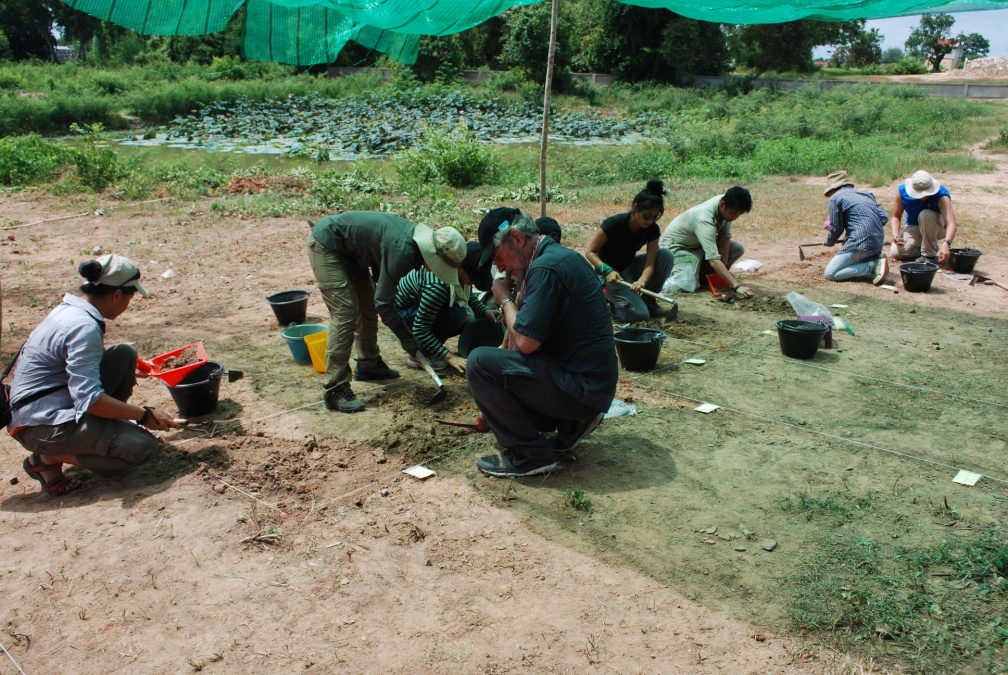
At least 61 ancient pottery-making kilns have been discovered at the site. A test excavation at one of them yielded a radiocarbon date in the 5th to 7th centuries, which if confirmed would make it the oldest kiln in Southeast Asia. From June 1-15, John Miksic of the Department of Southeast Asian Studies co-directed an excavation at Kiln Mong I with support from the Archaeology Unit, Institute of Southeast Asian Studies, and the Singapore Ministry of Foreign Affairs. Postgraduate students from Singapore, Cambodia, and 8 other countries in the East Asia Summit Group took part. The site yielded another radiocarbon date which falls in the 6th century, approximately in the middle of the same period as the earlier site. More research is necessary to confirm the dating, but the conclusion that the Khmer were already advanced in the field of pottery technology by this time sheds important new light on the formative period of Cambodian civilization before the rise of the kingdom of Angkor.

